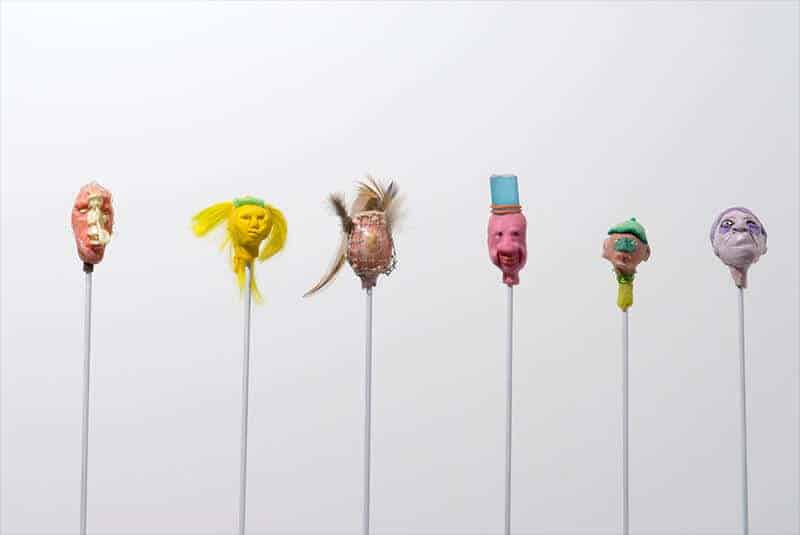
The Romans had lares, household gods placed at the thresholds of private homes. Scaled-down human figures, they watched unblinking over everyday activity, like classical CCTV. Shuffled down the divine pecking order, they nevertheless were the gods you’d most often see, who you’d shoot an entreating glance at when you stubbed your toe, or nicked your finger slicing onions. Catholic saints are scaled-down gods too, in a way: lose your keys and you pray to St Anthony; suffer a toothache and consult St Apollonia. God, by implication, is too big to bother with trifling things. And yet, as with the Romans, the saints have a more prominent role in daily life than the towering deityto which they’re subservient. After all, small events are the stuff of life. We are a sum of stubs and nicks. In Rebecca Nassauer’s new show, ‘Safekeepers’, at Josh Lilley Gallery, smallness is bigness, the insignificant significant. That she has created a pantheon of diminutive, watchful entities is all the more poignant for an artist staring down her own mortality. Each work is a residue of a long-lost religious rite designed to comfort in the shadow of death.
Nassauer’s work forces a visual adjustment through miniaturised scale. Ranks of figures in collagey configurations of glass, plasticine, bark, shells and feathers line up on shelves or float against the wall. They reward a beady eye. Tiny pins lodged in the whorl of a shell become, suddenly, tiny, unsettling eyes; a blue battery stops the mouth of a ceramic homunculus. Sculpture’s scale sets up physical sympathies between the viewer and the viewed – is it small, or are you huge? Whose scale are we talking about, anyway? Squinting, stooping, gawping, you feel yourself shrink, Alice-like. Glass shards and coarse clay bodies pull your own body’s frailty into sharper focus. Snappable and breakable bits tease your urge to touch. You can’t not look.
Heads are everywhere, winking, gurning, flirting. The visitor’s surprise at the work is that of the archaeologist shocked at the mad masks illuminated by his lantern. The surprise is not in the works’ confrontation – it’s in art’s perpetual ability to remind you that other people feel the way you do, too. And although Nassauer’s work is part of an art-historical continuum – there are occasional reminders of Joseph Cornell’s hoarded clutter, Paul Klee’s whimsical hand puppets, or Thomas Schutte’s leering grotesques – it’s more apposite to think of her work as part of a broader human impetus to make things as a way of making sense of life itself.
In Nassauer’s installation ‘Safekeepers’ (2009-10), 37 plasticine heads you could smuggle out in your palm (don’t, though) are skewered onto steel rods about five feet from the gallery floor, their bases covered in a field of salt, like a snowdrift. Each head contains its own exhilarating leaps of visual imagination. Bits of shell are wobbly, bulging chins. A plastic toy saxophonist, wedged in a face, becomes a witchy nose. In Nassauer’s work, picked-up bits and bobs integrate so fluently into the whole you’d think they were purpose-built. The joy of finding, hoarding, and cobbling-together runs through every work: you laugh out loud. Even when Nassauer’s medical condition is explicitly alluded to – in a mask with dreads made of catheters – it’s done with a willingness to laugh, tease, and find beauty in the darkest places. I’ve always hated the term ‘juvenilia’, but that’s what Nassauer’s work is, in the best possible way. Like Picasso’s very late work, it’s a return (not a regression) to the fundamentals of making by someone facing the loss of those faculties. It’s no surprise that, of the many figures in the show, only one has arms: and they’re baby arms, flailing about helplessly. Heads dominate. This is making about thinking, the body in decline contemplating the mind and what it holds, against all the odds.
That Nassauer’s show is being displayed in her son’s gallery might be cause for cynicism in the hard-hearted, of whom there’s no shortage in the art world. But consider the show a gesture, a mutual gift. Both the individual works and their installation in Lilley’s gallery generate a resonating hum: of belief in art’s strange power, of laughter in the dark, of love.